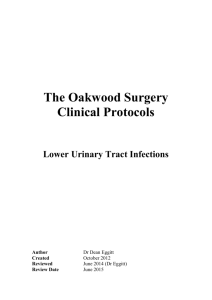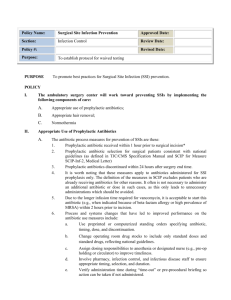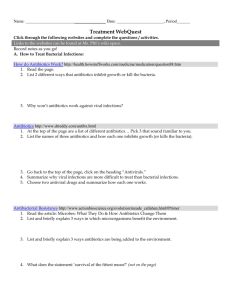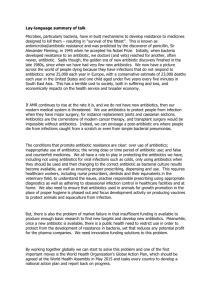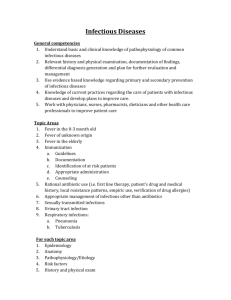Rational Antibiotic Use in Small Animal Practice – Specific Clinical
advertisement
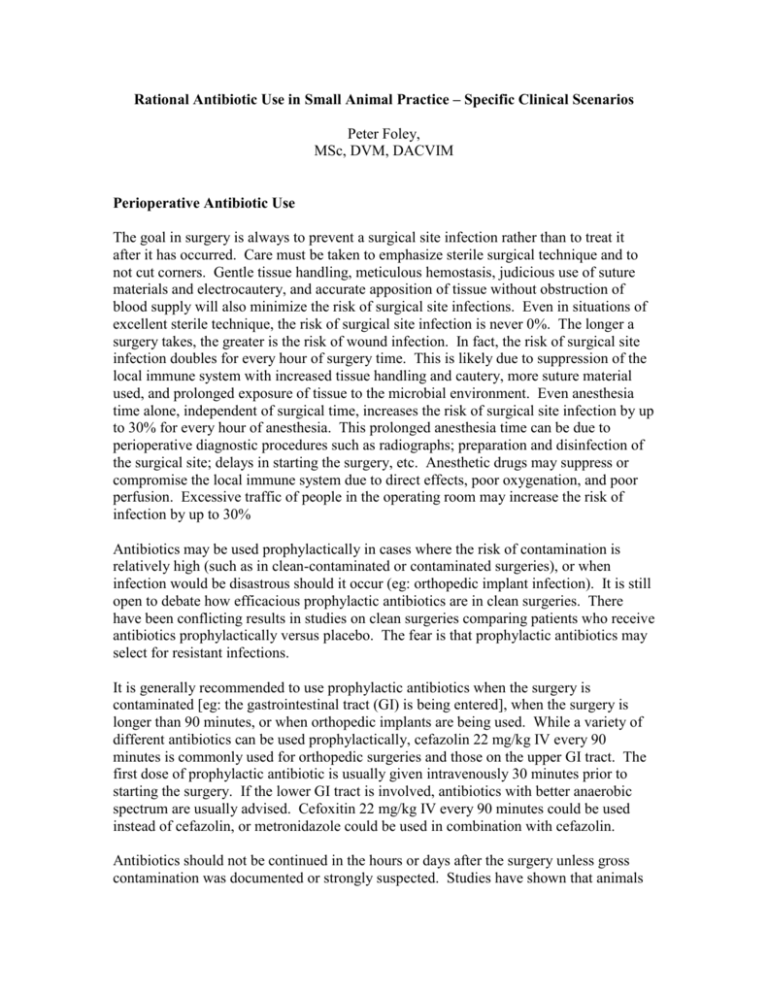
Rational Antibiotic Use in Small Animal Practice – Specific Clinical Scenarios Peter Foley, MSc, DVM, DACVIM Perioperative Antibiotic Use The goal in surgery is always to prevent a surgical site infection rather than to treat it after it has occurred. Care must be taken to emphasize sterile surgical technique and to not cut corners. Gentle tissue handling, meticulous hemostasis, judicious use of suture materials and electrocautery, and accurate apposition of tissue without obstruction of blood supply will also minimize the risk of surgical site infections. Even in situations of excellent sterile technique, the risk of surgical site infection is never 0%. The longer a surgery takes, the greater is the risk of wound infection. In fact, the risk of surgical site infection doubles for every hour of surgery time. This is likely due to suppression of the local immune system with increased tissue handling and cautery, more suture material used, and prolonged exposure of tissue to the microbial environment. Even anesthesia time alone, independent of surgical time, increases the risk of surgical site infection by up to 30% for every hour of anesthesia. This prolonged anesthesia time can be due to perioperative diagnostic procedures such as radiographs; preparation and disinfection of the surgical site; delays in starting the surgery, etc. Anesthetic drugs may suppress or compromise the local immune system due to direct effects, poor oxygenation, and poor perfusion. Excessive traffic of people in the operating room may increase the risk of infection by up to 30% Antibiotics may be used prophylactically in cases where the risk of contamination is relatively high (such as in clean-contaminated or contaminated surgeries), or when infection would be disastrous should it occur (eg: orthopedic implant infection). It is still open to debate how efficacious prophylactic antibiotics are in clean surgeries. There have been conflicting results in studies on clean surgeries comparing patients who receive antibiotics prophylactically versus placebo. The fear is that prophylactic antibiotics may select for resistant infections. It is generally recommended to use prophylactic antibiotics when the surgery is contaminated [eg: the gastrointestinal tract (GI) is being entered], when the surgery is longer than 90 minutes, or when orthopedic implants are being used. While a variety of different antibiotics can be used prophylactically, cefazolin 22 mg/kg IV every 90 minutes is commonly used for orthopedic surgeries and those on the upper GI tract. The first dose of prophylactic antibiotic is usually given intravenously 30 minutes prior to starting the surgery. If the lower GI tract is involved, antibiotics with better anaerobic spectrum are usually advised. Cefoxitin 22 mg/kg IV every 90 minutes could be used instead of cefazolin, or metronidazole could be used in combination with cefazolin. Antibiotics should not be continued in the hours or days after the surgery unless gross contamination was documented or strongly suspected. Studies have shown that animals that were given prophylactic antibiotics for days after surgery actually had a higher risk of developing infections than those who received no antibiotics. In the days postoperatively, the healing incision may look inflamed and the patient may run a slight fever (especially cats receiving hydromorphone). Such clinical signs may merely be due to normal inflammation and healing, and may not indicate bacterial infection. Any discharge from a surgical incision, however, is unusual, and is more likely to be due to an infection than normal healing. If a discharge is present, antibiotics may be considered to treat or prevent infection. Treating Urinary Tract Infections: First time bacterial cystitis: Urinary tract infections are relatively common in female dogs. If the patient is young or middle-aged, with clinical signs that are confined to the lower urinary tract (polakiuria and stranguria), some practitioners will simply prescribe a safe antibiotic that is excreted in high quantities in the urine without resorting to further diagnostic testing if it is a first time occurrence (eg amoxicillin 20-30 mg/kg PO q12hr). This is often the strategy pursued in human medicine. While this approach can work well in a lot of cases, it is ideal to perform a urinalysis and urine culture and sensitivity to determine if the bacteria isolated is susceptible to the antibiotic selected. Older dogs and cats and recurrent urinary tract infections: In older patients with lower urinary tract signs, and in cases where the urinary tract signs are recurrent, it is best to perform more extensive diagnostic testing to identify factors that may be predisposing the patient to urinary tract infections. In these patients, in addition to a urinalysis and urine culture and sensitivity, I recommend performing a complete blood count (CBC) and serum biochemistry profile to rule out endocrine or systemic diseases such as diabetes mellitus, hyperadrenocorticism, or chronic renal failure; and radiographs or ultrasound of the urinary tract to rule out bladder neoplasia or cystic calculi that may be harboring infection. In these patients I usually start therapy with amoxicillin 20-30 mg/kg PO q12hr while I am awaiting urine culture and sensitivity results. Interpreting Minimum Inhibitory Concentration (MIC) data: Disk diffusion (Kirby-Bauer technique) antibiotic susceptibility testing is usually sufficient for selecting an antibiotic that will be effective in a particular urinary tract infection, but it is important to remember that the concentration of the antibiotic in the test disk approximates the concentration that will be present in the patient’s serum. Some antibiotics, especially beta lactam antibiotics, are excreted in very high quantities in the urine. In fact many renally excreted antimicrobial drugs will reach urine concentrations 10 to 100 times greater than the concentration in serum. As a result, antibiotics that appear to have intermediate sensitivity on a disk diffusion susceptibility test may well be completely effective in treating a urinary tract infection. One way to more accurately determine the efficacy of an antibiotic in treating a particular urinary tract infection is to measure the MIC of a series of antibiotics against a particular urine sample. The MIC measures the concentration of the antibiotic that will inhibit growth of the bacterium in question. The concentration of the antibiotic that is likely to be bactericidal is four times the MIC. In order to use MIC data, you need to know the concentration of antibiotic that is likely to be present in urine. There are tables listing these concentrations of common antibiotics in most textbooks with chapters on treating urinary tract infections (eg: Greene’s Infectious Diseases of the Dog and Cat, 4th ed, page 1029; and Ettinger and Feldman’s Textbook of Veterinary Internal Medicine, 7th ed, page 2042). Recurrent UTI When a urinary tract infection keeps recurring, a careful diagnostic investigation should be conducted to try to identify what host factors may be predisposing the patient to the infections. A urine culture and sensitivity (ideally including MIC) should be performed to determine which antibiotics should be successful. A urinalysis should be performed to rule out the presence of glucosuria. A CBC and serum biochemistry profile should be performed to identify systemic diseases that may reduce host immunity in the urinary tract, for example: neutropenia, hyperadrenocorticism, diabetes mellitus, and chronic renal failure. Abdominal radiographs and ultrasound can help identify uroliths, bladder masses, and any other anatomic abnormalities that could be predisposing the patient to infections. Contrast radiographs or CT, or cystoscopy may also be required to fully rule out anatomic abnormalities like ectopic ureters. Long-term suppressive antibiotic therapy (periodic antimicrobial dosing) Some patients can have frustrating, recurrent episodes of urinary tract infections despite appropriate antibiotic selection and no evidence of underlying predisposing factors. One controversial therapy in these situations is to give chronic once daily antibiotics to try to keep infections from recurring. The antibiotic is usually given just before bedtime so that it accumulates and remains in the bladder overnight. Examples of antibiotics that have been used in this way include amoxicillin, cephalexin, trimethroprim sulpha (TMS), and enrofloxacin. This therapy is controversial because studies proving its efficacy are lacking, it may encourage the development of antimicrobial resistance, and it may be used as a substitute for appropriate diagnostic investigation into predisposing factors. If suppressive therapy is to be used at all, it should be as a last resort after any urinary tract infection has been at least temporarily eliminated, and a full diagnostic workup has been performed. Antibiotics with urinary catheters Urinary catheters may introduce bacteria into the urinary bladder. Even if the catheter is placed completely aseptically, the presence of foreign material impairs the local immune system function and serves as a conduit of bacteria into the urinary tract. Urinary tract infections are common a few days after placement of a urinary catheter, even if a closed urine collection system is used. This is because the bacteria can travel up the outside of the catheter even more easily than up the lumen of the catheter. Given this likelihood of a UTI, some veterinarians may be tempted to place the patient on prophylactic antibiotics at the time of catheter placement to try to prevent an infection from becoming established. This would be a mistake, however, as there is little evidence that prophylactic antibiotics prevent infection – instead they merely tend to promote the development of an infection that is resistant to the antibiotic selected. Antibiotics should, therefore, be avoided in patients with an indwelling urinary catheter. It is prudent to culture the urine at the time the catheter is removed to document any bacterial infections that may have been introduced by the catheter. In some cases, it may be necessary to have a patient on antibiotics while a urinary catheter is in place, despite this propensity for selecting for a resistant infection. Such cases include patients with a life-threatening bacterial infection (eg: sepsis) who must have a urinary catheter in place (eg: urethral obstruction, paralysis, profound debilitation, etc). In these cases where the patient must be on antibiotics at the same time as a catheter is in place, it is especially important to culture the urine at the time the urinary catheter is removed, to document what bacteria might be present and what antibiotics they are susceptible to. Antibiotics and feline lower urinary tract disease (FLUTD) Bacterial cystitis is rare in cases of FLUTD. Antibiotic use in FLUTD is not warranted, and is potentially dangerous, unless a bacterial infection can be detected on urine culture. Occult urinary tract infections Occult urinary tract infections are those in which a bacterial infection is documented on urine culture, and yet the patient is experiencing no clinical signs of infection (ie: no evidence of stranguria, polakiuria, dysuria, and hematuria). These infections are relatively common in patients with diabetes mellitus and hyperadrenocorticism. The conventional wisdom in the past was to always treat these infections with appropriate antibiotics, based on sensitivity data, in an attempt to decrease the risk of more serious ascending infections (ie pyelonephritis). Some have advised against treating occult UTIs as there is little evidence that it is beneficial, and some evidence from human medicine that it might actually increase the likelihood of recurrent UTI. The treatment of occult UTI in human medicine is currently discouraged, and the issue of treating occult UTI in animals is currently being debated in the American College of Veterinary Internal Medicine. Lyme Disease The question often arises whether to treat with antibiotics every animal that tests positive for Lyme disease on a 4Dx snap test. The usual policy is to treat positive animals only if they have clinical signs that could be attributed to Lyme disease (lameness, proteinuria, anorexia, etc). A dog that tests positive, but has no clinical signs may be one of the many dogs that have had a subclinical infection, and were able to clear the infection. In human medicine, taking a single dose of doxycycline within 72 hours of being bitten by a tick has been shown to be effective in preventing Lyme disease. No such study has yet been performed in dogs. At present, most internists do not recommend automatically treating every dog that has been bitten by a tick. While doxycycline (10 mg/kg PO q12-24hr for 4 weeks) is most commonly prescribed for Lyme disease, amoxicillin (20 mg/kg PO q8hr for 4 weeks) also seems to be effective. Leptospirosis The drug of choice for Leptospira infections in dogs is doxycycline 5 mg/kg PO or IV q12hr for 2 weeks. In patients that are vomiting, ampicillin (20 mg/kg IV q6hr) can be used instead, until the patient is able to begin a 2 week course of doxycycline. Other dogs living in the house with a dog with clinical leptospirosis may become infected from the sick dog, or may have been exposed to the same source of infection as the sick dog. Because of this, and the risk of zoonotic transmission of leptospirosis to humans in the household, it is currently recommended to treat all other dogs in the household with doxycycline 5 mg/kg PO q12hr for 2 weeks, and ideally check their acute and convalescent titres against Leptospira. Anaplasma phagocytophilum Anaplasmosis is rare in the Atlantic region, but at least one case has been documented. It causes a variety of non-specific clinical signs including lethargy, anorexia, lameness, stiffness, and oculo-nasal discharge. Mild to marked thrombocytopenia is typically, but not always present. The 4Dx snap test is the most common way to diagnose infection. The most common treatment is with doxycycline 5-10 mg/kg PO q12hr for 14-21 days. Upper respiratory infections in cats Upper respiratory infections (URI) in cats are very common. Usually viruses such as herpes and calici are involved, but occasionally Chlamydia and Bordetella can be involved. Opportunistic bacterial infections are common after the initial viral infections have disrupted the host defense mechanisms. Because antibiotics are ineffective in treating the most common causes of URI in cats (herpes and caliciviruses), antibiotic therapy is usually reserved for cases where a significant suspicion of Chlamydia or Bordetella is present, or where the cat has a thick, green nasal discharge and anorexia, suggesting the presence of a secondary bacterial infection. Antibiotics commonly used in these situations include doxycycline 5 mg/kg PO q12hr for 14-21 days, TMS 15 mg/kg PO q12hr for 7-14 days, enrofloxacin 5 mg/kg PO q24hr for 7-14 days, and azithromycin 5-10 mg/kg PO q24hr for 3-5 days. At AVC we are currently conducting a study of shelter cats with URI, attempting to identify the prevalence of herpes virus, calicivirus, Chlamydia, and Bordetella. In the case of any Bordetella isolates cultured, we are also performing sensitivity to determine what antibiotics are effective against these strains. Bordetella bronchiseptica infections in dogs Many cases of bordetellosis are mild and resolve without the need of antibiotics. In these cases, the patient remains bright with an adequate appetite. In cases where the patient is more severely affected, antibiotics may be required. Ideally an oropharyngeal swab, transtracheal wash, or bronchoalveolar lavage should be cultured as this organism displays a high level of antimicrobial resistance. While culture results are pending, empirical treatment with doxycycline 5 mg/kg PO q12hr, amoxicillin-clavulanate 12.5-25 mg/kg PO q12hr, or TMS 15-30 mg/kg PO q12hr are usually selected. Parvoviral enteritis While parvoviral enteritis is obviously caused by a virus that is obviously immune to antibiotics, the profound immunosuppression the virus causes by its destruction of rapidly dividing bone marrow stem cells leaves the host open to potentially fatal opportunistic infections from normal gastrointestinal (GI) bacteria. This mixed bag of bacteria requires a broad spectrum of antibiotic coverage. Since the patients most commonly affected by parvoviral infection are growing puppies, enrofloxacin should ideally not be used, as it has been know to cause joint damage in growing animals. If the patient is not yet profoundly neutropenic, ampicillin 22 mg/kg IV q6hr is usually prescribed. If the patient becomes profoundly neutropenic, gentamycin 6.6 mg/kg IV q24hr is usually administered along with the ampicillin if the patient is well hydrated (to avoid renal toxicity). If the patient is not well hydrated, cefoxitin 22 mg/kg IV q6-8hr can be given as a single agent. Aspiration pneumonia Aspiration pneumonia can occur with severe vomiting or regurgitation, particularly in severely debilitated animals, animals under general anesthesia, and animals with esophageal disease. While the worse damage to the lungs in aspiration pneumonia is thought to be caused by the introduction of gastric acid into the lungs, GI bacteria are also introduced into the lungs and can grow in the damaged lung tissue. Ideally a sample of lung or tracheal fluid (transtracheal wash or bronchoalveolar lavage) should be cultured to determine which antibiotics should be selected. In many pneumonia patients, however, their degree of respiratory compromise places them at significant risk for these diagnostic procedures. Often a broad spectrum combination of antibiotics, such as ampicillin 22 mg/kg IV q6-8hr and enrofloxacin 5 mg/kg IV q24hr, is selected to combat the various types of GI bacteria that might be present. After a few days, if the animal is eating adequately, they can be switched to oral amoxicillin and enrofloxacin and discharged from the hospital. It can take several weeks to clear the infection. It is recommended to recheck thoracic radiographs every two weeks to chart recovery. The antibiotics should be continued for 2 weeks beyond resolutions of radiographic signs of pneumonia (a minimum of 4 weeks). Bite and scratch wounds and abscesses If abscesses are present, lancing and lavaging them is more important than antibiotic therapy in clearing the infection. In many cases antibiotics are probably not even required. The problem comes when it is unclear if there is a concurrent bacterial cellulitis or fasciitis that would benefit from antimicrobial therapy. Culture of the abscess or wound is useful in determining what antimicrobial therapy would be most appropriate. While culture results are pending, a variety of antibiotics could be selected. I usually choose amoxicillin-clavulanate 12.5-25 mg/kg PO q12hr. Necrotizing fasciitis This fulminant infection of the skin, subcutis, and fascia is most commonly caused by βhemolytic group G Streptococcus organisms. Aggressive surgical debridement of the affected tissue and intensive supportive care are essential in the treatment of these cases. Culture and sensitivity will help determine the most appropriate antibiotic, but clindamycin 5-10 mg/kg IV q12hr seems to be the best choice while awaiting culture results. Bacterial prostatitis This is a disease of intact male dogs. Castration usually results in clearing of the infection and prevention of recurrence. Urine culture or prostatic wash can help determine the most appropriate antibiotic to use. Penetration of antibiotics into the prostate gland is difficult. Enrofloxacin 5 mg/kg PO q24hr or TMS 15-30 mg/kg PO q12hr are usually selected for their ability to penetrate the prostate gland. Sepsis Sepsis caused by GI bacteria (eg: severe enteritis, peritonitis, and pyometra) requires a broad spectrum coverage (eg: ampicillin 22 mg/kg IV q6hr and enrofloxacin 5 mg/kg IV q24hr) while culture and sensitivity results are pending. Often surgery is urgently required to address the source of the sepsis (eg: intestinal rupture). Pyoderma In patients with pruritic skin lesions, skin scraping cytology and/or impression smears are useful in ruling in bacterial pyoderma, and ruling out yeast and mites. If it is a simple, isolated case of bacterial pyoderma, cephalexin 30 mg/kg PO q12hr or cefpodoxime 5-10 mg/kg PO q24hr for 14-28 days are often sufficient in clearing most infections. If the pyoderma is relapsing/recurrent, there is often an underlying predisposing cause that should be identified (eg: atopy, hypothyroidism, hyperadrenocorticism). If the infection is non-responsive to the initially selected antibiotic, the skin should be cultured to determine which bacterium is present [especially to rule out methicillin-resistant Staphylococcus pseudointermedius (MRSP)]. While awaiting culture and sensitivity results, topical therapy with chlorhexidine or other antibacterial shampoo can be initiated. Bacterial otitis externa Bacterial otitis externa is usually secondary to some underlying predisposing factor (eg atopy or seborrhea). Once the infection becomes established, inflammation inadvertently creates an excellent environment in the ear canal for the growth of bacteria: a warm, moist, narrowed ear canal with poor circulation of air. Most topical combination antimicrobial and anti-inflammatory ear medications are effective in decreasing the inflammation in the canal and eliminating the bacteria. I have had considerable success with topical 2% Burrow’s solution and 1% hydrocortisone in propylene glycol (q12hr for 7-14 days). The Burrow’s solution is an astringent that dries up the ear, and the hydrocortisone decreases the edema and heat caused by inflammation in the ear canal. It is now my first choice in dealing with bacterial otitis externa.


